| |
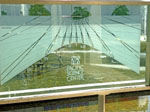 |
Seattle |
Washington |
USA |
Vertical Dial |
Dial 795 |
| A 4 foot wide by 1.5 foot high etched glass plate vertical dial. The gnomon is formed by crossed bars several inches behind the plate and casts its shadow on hour line analemmas. Roman hour numerals for 10 AM to 4 PM are scribed under each analemma; other hours are Arabic. Solstice and equinox lines are scribed across the plate, as are narrow lines at 10 day intervals. Months of the year are scribed about the plate perimeter. A description of the dial is marked on the left side of the plate and the fountains are visible through the plate |
| |
| |
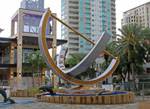 |
St. Petersburg |
Florida |
USA |
Equatorial Dial |
Dial 794 |
| A very large bowstring equatorial dial. The outer diameter of the equatorial ring is 26 feet, the height of the meridian ring is 22 feet above the base and the gnomon rod is 26.5 feet long, making this possibly the largest bowstring dial known at this time. The equatorial ring is marked on two faces with large Roman hour numerals for 7 AM to 5 PM. The dial base includes a large compass rose marked with major directions. |
| |
| |
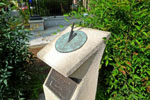 |
Washington |
DC |
USA |
Horizontal Dial |
Dial 793 |
| An incorrectly installed but prominently displayed 8 inch bronze horizontal dial with hour, half-hour and quarter-hour lines and Roman hour numerals from 5 AM to 7 PM. The bronze gnomon is inclined from the dial face approximately 42° and the hour lines appear correct for that latitude, though the local latitude is about 39°. |
| |
| |
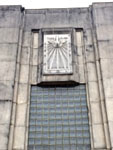 |
Senatobia |
Mississippi |
USA |
Vertical Dial |
Dial 792 |
| A south facing vertical dial placed above a window high on a wall of a high school. The dial face includes hour lines and Arabic hour numerals 6 AM to 6 PM. The dial is a separate plate affixed to the wall. The dial may be viewed from College Street side of the building. |
| |
| |
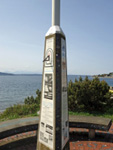 |
Seattle |
Washington |
USA |
Vertical Dial |
Dial 791 |
| A south facing vertical dial on a chamfered triangular pillar. The gnomon is slightly bent. The dial face includes hour lines with Arabic numerals for Pacific Standard Time and PDT, the approximate coordinates and the magnetic declination. |
| |
| |
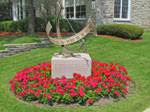 |
Scarborough |
Ontario |
Canada |
Equatorial Dial |
Dial 790 |
| A 45 inch diameter bronze equatorial ring dial with an arrow-pointed rod gnomon. The dial is mounted atop a 36 inch square pink granite plinth with chamfered corners sitting on a concrete base. |
| |
| |
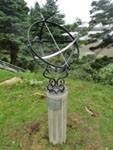 |
Northern Bay |
Newfoundland |
Canada |
Armillary Sphere |
Dial 789 |
| An approximately 24 inch diameter steel and aluminum armillary dial with wrought iron scrollwork base. The equatorial ring includes an aluminum plate inscribed with hour, half-hour and five minute marks showing time from 5 AM to 7 PM. A plaque on the pillar below shows combined corrections for EOT and longitude. The dial is mounted on a 10 inch fluted concrete pillar, reinforced with steel rebar. |
| |
| |
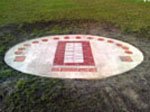 |
Howell |
Michigan |
USA |
Analemmatic Dial |
Dial 788 |
| A 16 by 20 foot, two-tone concrete analemmatic dial with 7 AM to 8 PM Arabic hour numerals on 12 inch round stamped concrete disks. Instructional and use information is shown on impressed lettering colored concrete plates. |
| |
| |
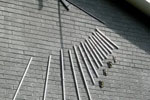 |
Falls Church |
Virginia |
USA |
Vertical Dial |
Dial 787 |
| A large vertical dial on the southwest brick wall of a private home. The hour lines are square PVC stock. Arabic hour numerals for noon to 7 PM are brass plated figures mounted on brass plaques. The dial declines 54 degrees from south to west. The ends of the hour lines indicate the solstices except for several long summer hour lines. The equinoctial points are marked by red glass inserts on the hour lines. |
| |
| |
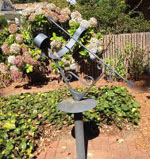 |
Capitola |
California |
USA |
Equatorial Dial |
Dial 786 |
| A wrought iron equatorial dial with an arrow rod gnomon. Equatorial band and support have iron scroll work depicting a bow and arrow. Dial is painted and hour numerals are obscured. |
| |
| |
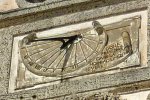 |
Miami |
Florida |
USA |
Vertical Dial |
Dial 785 |
| An east-declining vertical dial near the top of a stone winter residence building, now a museum. Dial face includes hour lines and Roman hour numerals for 5 AM to 3 PM. Building and dial were built in the early 1900s but gnomon appears to be in good condition without corrosion so it may be bronze. Dial includes a depiction of a scroll with engraved Latin inscription. |
| |
| |
 |
Quincy |
Illinois |
USA |
Analemmatic Dial |
Dial 784 |
| A 10 foot x 18 foot analemmatic dial built of Keystone Blue granite from the quarry in Elberton, Georgia. Hour markers for 7 AM to 5 PM show Arabic numerals and identify the organizations donating to fund the dial. Each hour marker depicts the morphology of a leaf from a tree located in the nearby arboretum. The hour markers are 15 inches in diameter and 6 inches thick, weigh 102 pounds each and are placed flush with the soil to reduce potential for vandalism. |
| |
| |
 |
Farmington |
Utah |
USA |
Horizontal Dial |
Dial 783 |
| A 28 x 20 x 2 inch sandstone horizontal dial with a 1/2-inch thick, hand-tooled copper gnomon. Dial face has Arabic numerals and hour lines corrected for local longitude. Dial was hand carved with carbide chisels and maul but using techniques and natural stone used to create ancient Native American petroglyphs found in the southwest USA. Dial is mounted 2 inches above a sandstone base weighing 400 pounds by brass leveling pins; this mounting makes the dial appear to "float" above the stone base.
A "Desert Varnish" finish has been applied to the dial face using a natural process that mimics what naturally happens to exposed sandstone over several thousands of years. The natural color of the stone is exposed by the carving process to create a color contrast as might be seen in a Native American petroglyph.
Dial is located in the front yard of a private residence. Viewing can be arranged by contacting the owner by email at theoperativemason@gmail.com |
| |
| |
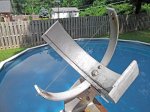 |
Muncie |
Indiana |
USA |
Equatorial Dial |
Dial 782 |
| A 9.5 inch wide bowstring equatorial dial built using the aluminum photo drum of a xerographic copier machine. The gnomon is stretched fishing line. Hour lines and numerals are marked by lead pencil and include 5-minute marks. The hour ring can be rotated to set for standard or daylight saving time and the elevation angle is adjustable. The dial is mounted on the deck railing of a swimming pool. |
| |
| |
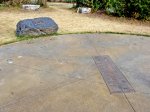 |
Calgary |
Alberta |
Canada |
Analemmatic Dial |
Dial 781 |
| A school yard 6 by 4 meter analemmatic dial of pigmented concrete. The Sunclocks registered design has two hour ellipses, the outer one for standard time, the inner one for daylight saving time. The zodiac table is larger for the fall and winter periods so the design is really two sundials in one. Longitude correction is included. The plaque provides instructions in French and English and notes the dial marks the 50th anniversary of Ecole Banff Trail.
The plaque instruction to stand on the current month is misleading; the user should straddle the dial centerline to avoid an offset error. |
| |
| |
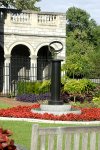 |
Windsor |
Ontario |
Canada |
Armillary Sphere |
Dial 780 |
| A simple armillary dial about two feet in diameter with an equatorial hour ring. The dial is mounted atop a tall, black cylindrical pillar within a formal garden of Willistead Manor. The manor is open to the public on selected days. |
| |
| |
 |
Windsor |
Ontario |
Canada |
Noon Mark or Meridian Dial |
Dial 779 |
| A 12 foot high noon mark dial consisting of two closely spaced triangular vertical plates, a protruding needle and pairs of summer and winter solstice "wings" that together project a shadow onto the surrounding concrete deck within a 40 foot diameter reflecting pool.
When the sun totally illuminates the narrow space between the vertical plates, it is local noon and the shadow cast by the protruding needle points true north. On the summer solstice, the shadow cast by the smaller, upper solstice wings will be at its narrowest width. On the winter solstice, the shadow cast by the lower solstice wings will be at its narrowest width. |
| |
| |
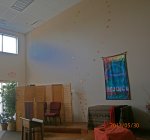 |
Sterling |
Virginia |
USA |
Gnomonic or Projection Dial |
Dial 778 |
| A reflection dial using a mirror in an upper window to project a solar image spot onto the west facing vertical interior wall of a church. Copper medallions on the wall show the spot location at 10:30 AM throughout a year and depict the analemma curve. |
| |
| |
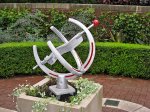 |
St. Louis |
Missouri |
USA |
Equatorial Dial |
Dial 777 |
| A cast aluminum equatorial dial 15 inches in diameter with a rotating, two-part, three-dimensional analemmic gnomon; this is a classic Schmoyer dial completed by Bill Gottesman. One gnomon half is used from summer solstice to winter solstice; time is shown by a beam of light passing through the gnomon slit to fall on the hour ring. The other gnomon half is used from winter solstice to summer solstice. |
| |
| |
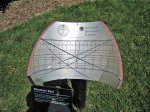 |
St. Louis |
Missouri |
USA |
Equatorial Dial |
Dial 776 |
| A 10 inch wide, cylindrical-segment equatorial dial 8 inches high, fabricated from a section of large PVC pipe. The dial face is aluminum sheet bonded to the PVC pipe and marked by photochemical engraving with hour lines showing analemmas to correct for EOT; hour lines are corrected for longitude and show both standard and daylight saving Arabic hour numerals. Winter and summer solstices and equinoxes are marked. Time and date are read by the shadow of the intersection of the two gnomon rods. Instructions are included on the dial face and plaque. |
| |
| |
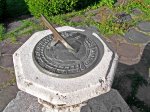 |
St. John's |
Newfoundland |
Canada |
Horizontal Dial |
Dial 775 |
| A 10 inch diameter heavily cast bronze horizontal dial with bronze gnomon that was apparently replaced or remounted in the past. The dial face includes hour and half-hour lines and Roman hour numerals from 5 AM to 7 PM. The center of the dial face shows a simplified map of the world.
The dial sits atop a stone pedestal with a two-part octagonal base. The base is inscribed with a dedication to the memory of Sir Edgar Rennie Bowring, K.C.M.G. (1858-1943), industrialist, born at St. John's, Newfoundland on August 17, 1858, son of John Bowring and Mary Rennie. |
| |
| |
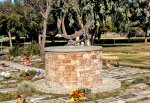 |
Santa Clara |
California |
USA |
Equatorial Dial |
Dial 774 |
| A 5 foot 9 inch wide cast bronze ring equatorial dial on a low brick mortared pedestal. The full semicircular hour ring has hour, half-hour, fifteen minute and 5 minute marks, and Roman hour numerals. The dial is lightly patinated and has a central gnomon rod with arrowhead. |
| |
| |
 |
Reston |
Virginia |
USA |
Analemmatic Dial |
Dial 773 |
| An analemmatic dial with 8 foot semimajor axis painted on the asphalt playground of the Neil Armstrong Elementary School. Hour marks for 5 AM to 7 PM include longitude correction; Arabic hour numerals for both standard and daylight saving time are shown. The date line is decorated in bright colors with icons symbolic of holidays and seasonal weather.
The dial was the Boy Scout Eagle Service Project of William T. Spriggs and was painted by local Boy Scouts and their fathers. |
| |
| |
 |
Phoenix |
Arizona |
USA |
Vertical Dial |
Dial 772 |
| A dual-vertical cube dial with two 12 inch square dial plates declining 45? south of east and south of west. The east face shows hour lines for 6 AM to 12 PM; the west face shows hour lines for 12 PM to 6 PM. Roman numerals mark three hour lines on each face. |
| |
| |
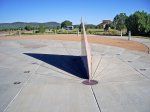 |
McDonald Observatory |
Texas |
USA |
Horizontal Dial |
Dial 771 |
| A monumental horizontal dial on a cast concrete base with a 5 foot high polished granite gnomon. Hour lines radiate from the gnomon root and hour markers with Arabic numerals are placed on a square about the gnomon. Instructions for reading the dial are engraved on the side of the gnomon. |
| |
| |
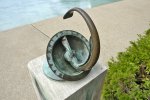 |
Bloomfield Hills |
Michigan |
USA |
Equatorial Dial |
Dial 770 |
| An equatorial dial of cast bronze. The heavily patinated dial has Roman hour numerals IIII through VIII and a cast bronze pointer marked, "DAYLIGHT SAVING." It has an unusual crescent shaped arm with notch at the upper end. The arm is rotated until sunlight passes through a hole in the upper arm and strikes an analemma with monthly dates on the lower inner curve of the crescent. Time is then read on a circular dial from an "hour hand" pointer extending from the base of the crescent. The dial sits atop a marble pedestal engraved: "The A.N. Goddard Sundial" |
| |
| |
 |
Croton-on-Hudson |
New York |
USA |
Horizontal Dial |
Dial 769 |
| A 13-1/2 foot tall monumental horizontal dial memorial to the victims and responders of the 9/11/2001 World Trade Center terrorist attack. The memorial sundial gnomon is created from an 11000-pound, 14-foot long twisted steel beam once part of the North Tower of the World Trade Center. The gnomon is held at an angle of 41 deg 12 minutes by a 16-ton boulder with inset channel to cradle the twisted steel. |
| |
| |
 |
Corregidora |
Queretaro |
Mexico |
Gnomonic or Projection Dial |
Dial 768 |
| A projection (or, "negative") dial using the south-facing wall and floor of the "Cosmic Room" of a "casa de campo" private cottage. The tile roof over this room contains several skylights with slits for projecting a beam of sunlight onto the wall and one skylight with a small hole to project a dot of sunlight onto the room floor. |
| |
| |
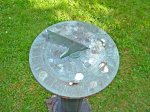 |
Carbonear |
Newfoundland |
Canada |
Horizontal Dial |
Dial 767 |
| A 10 inch diameter horizontal bronze dial with engraved nomenclature. Hour numerals 4 AM to 6 PM are Roman; ten minute numerals are Arabic and two minute marks are shown. Minute numerals are engraved in sequence 60, 20, 40, 60. Face engravings include EOT dates, "WATCH FASTER" and "WATCH SLOWER" and a central compass rose. |
| |
| |
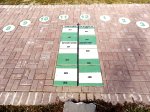 |
Nashville |
Tennessee |
USA |
Analemmatic Dial |
Dial 766 |
| A 16 x 12 foot analemmatic dial placed in the Experience Center of the 200 acre Ellington Agricultural Center. Dial is built of paver stones flush to the surroundings with painted inset circular hour marker paver stones and rectangular paver stones for the central date line. Directions for use are painted on the date line. |
| |
| |
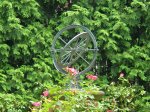 |
Annapolis |
Maryland |
USA |
Armillary Sphere |
Dial 765 |
| A bronze armillary dial with meridian, horizon and equatorial rings on a concrete pedestal. Dial is located in Government House residence and requires a tour of the property for access. |
| |
| |
 |
Coalinga |
California |
USA |
Horizontal Dial |
Dial 764 |
| A 26 inch diameter hand-carved, lacquer-coated beige sandstone horizontal dial set flush in a massive cast concrete pedestal. Dial has a thick stone gnomon, hour, half-hour and quarter-hour lines with Arabic ST hour numerals corrected for longitude. Face is marked with symbols showing sunrise and sunset times on solstices and equinoxes and with location coordinates. Dial face includes a hand carved graphic of a Valley Oak tree, symbolic of the San Joaquin Valley dial location.
The dial is embedded in a three foot cube cast concrete pedestal bearing a bas relief image of a horned toad, mascot of the Coalinga High School and the city centennial dates 1906 - 2006. |
| |
| |
 |
Lake Oswego |
Oregon |
USA |
Analemmatic Dial |
Dial 763 |
| An analemmatic dial with 20 foot major axis, 14 foot minor axis with hour markers and date line made of sandblasted concrete paver stones. A platform stand on the west side holds instructions on using the dial.
A preliminary version of this dial was included on the 2009 NASS Conference Sundial Tour. |
| |
| |
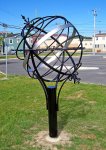 |
Carbonear |
Newfoundland |
Canada |
Armillary Sphere |
Dial 762 |
| A four foot diameter armillary dial built of 1.5 x 0.5 inch flat steel bar and 3/4 inch steel rod. A 1/2 inch steel rod gnomon casts the shadow on an aluminum equatorial ring, which includes hour and 5 minute marks. Dial includes horizon, equator, ecliptic, tropic, Arctic and Antarctic Circle rings. |
| |
| |
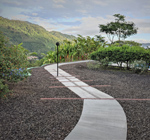 |
Orosi Valley |
Cartago |
Costa Rica |
Obelisk or Vertical Gnomon |
Dial 761 |
| A 25 foot long point-in-space or nodus dial. The horizontal dial face is cuartilla (crushed stone). The 8 AM - 4 PM hour lines are red adoquines (bricks) and the noon hour line is lodged between gray adoquines. The dial equinox line is a row of gray adoquines. Solstices are identified by the curve formed by the tips of the hour lines. The gnomon atop a 1.8 m high vertical rod is a 21 cm diameter sphere, hand carved out of gabbro, a rock formed from molten magma. It is a replica of bolas de piedra (stone balls) created a thousand years ago by the local Diquis indigenous people and discovered in 1930. |
| |
| |
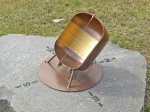 |
Wynndel |
British Columbia |
Canada |
Cylindrical Dial |
Dial 760 |
| A ring equatorial dial built inside a cross-sectioned propane LPG tank. The equatorial surface has an inset plaque that shows EOT corrected time and includes declination lines for date shown by the shadow of the nodus on the polar gnomon wire. Dial sits on a granite block pedestal that shows cardinal directions. |
| |
| |
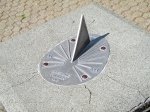 |
White Rock |
British Columbia |
Canada |
Horizontal Dial |
Dial 759 |
| A 9 x 12 inch stainless steel horizontal dial with 4 AM to 8 PM hour lines and Roman hour numerals for 6 AM and 6 PM. Dial is set on a 24 inch square capital atop a 30 inch high pedestal of concrete and local stones. This pedestal sits on a 50 inch square concrete base that was saved when the railway was moved in 1984 |
| |
| |
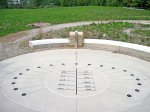 |
White Lake |
Michigan |
USA |
Analemmatic Dial |
Dial 758 |
| A 20 x 10 foot concrete analemmatic dial with Arabic numeral hour markers for 3 AM to 9 PM. A single central date line is painted on the dial face. Segmented raised seating surrounds the dial; slump stone block pillars mark the cardinal directions. A raised plaque provides dial information and directions for use. |
| |
| |
 |
Waterbury |
Connecticut |
USA |
Armillary Sphere |
Dial 757 |
| A 24 inch diameter armillary with meridian, horizon, equatorial, tropic, Arctic and Antarctic rings. Equatorial ring is engraved with Roman hour numerals. The dial is supported on a narrow 4 foot tall granite pedestal.
The pedestal includes a plaque with an EOT graph and is inscribed to indicate the dial is the Class Gift of 2010. |
| |
| |
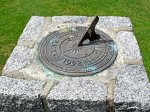 |
Victoria |
British Columbia |
Canada |
Horizontal Dial |
Dial 756 |
| A 12 inch diameter cast bronze horizontal dial with hour lines, quarter-hour marks and Roman hour numerals. Dial face includes a central compass rose with cardinal directions; large characters inscribe RVYC and 1992. Dial sits atop a tapered mortared stone pedestal |
| |
| |
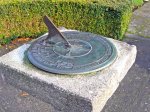 |
Victoria |
British Columbia |
Canada |
Horizontal Dial |
Dial 755 |
| A 12 inch diameter cast bronze horizontal dial with hour lines, quarter-hour marks and Roman hour numerals. Dial face includes a central compass rose with cardinal directions. The dial sits atop a cast decorative concrete pedestal. The dial is correctly designed for the location and is one of at least seven such dials in the Victoria area. |
| |
| |
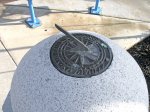 |
Victoria |
British Columbia |
Canada |
Horizontal Dial |
Dial 754 |
| A 9 inch diameter cast bronze dial with hour and half-hour marks and Roman hour numerals. The dial face has a compass rose at the center with cardinal and ordinal directions. The casting is of poor quality and the gnomon, brazed in place, is bent and at the wrong angle.
The sundial is a monument to the Point Hope Shipyard. Engraved on one side is the history of the shipyard, the oldest in British Columbia, renovated and reopened in 2007. The cast dial pedestal is marked, "This newel post was saved from the demolition of St. Mary's Hospital, Victoria. |
| |
| |
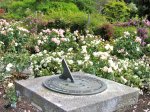 |
Victoria |
British Columbia |
Canada |
Horizontal Dial |
Dial 753 |
| A 12 inch diameter cast bronze horizontal dial with hour lines, quarter-hour marks and Roman hour numerals. Dial face includes a central compass rose with cardinal directions. The dial sits atop a cast concrete pedestal sculptured with curves, fronds and cherubs. However the dial may be misaligned from true North. The gnomon angle appears close to the dial's latitude (measured at 49.2°). |
| |
| |
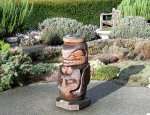 |
Victoria |
British Columbia |
Canada |
Horizontal Dial |
Dial 752 |
| A bronze horizontal dial with hour lines, quarter-hour marks and Roman hour numerals. Dial face includes a central compass rose. The dial sits atop a carved cedar totem depicting an Orca killer whale. The totem is carved in the Coastal Salish tradition by Aubrey LaFortune, a member of the Cowichan Band of native Canadians. |
| |
| |
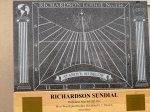 |
Stouffville |
Ontario |
Canada |
Vertical Dial |
Dial 751 |
| A 42 x 72 inch, 10 inch thick, 3300 pound black granite vertical dial on a 5 foot high steel tube pedestal. Gnomon is a 5/16-inch stainless steel shaft with a dowel-type nodus to mark solar declination. Dial shows EDST with longitude correction. Dial face includes hour and half-hour lines, and equinox and winter and summer declination lines. Dial center is the pivot of the compasses in the Masonic Square and Compass emblem, with oak leaves.
Below the dial is a 12 x 72 inch oak plaque inscribed with dedication information and two brass plaques with dial information and EOT graph. |
| |
| |
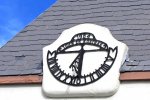 |
Solvang |
California |
USA |
Vertical Dial |
Dial 750 |
| A cast or wrought iron vertical dial about 3 foot square painted black, prominently mounted at the roof line of the Royal Copenhagen Inn. The dial face has hour lines, half-hour marks and Roman hour numerals. The dial in not quite gnomonically correct as the building declines a few degrees west of south and the gnomon appears to be at 45? rather than 34.5?. The dial is visible from Mission Road.
An interesting wind vane is seen on the roof peak above the dial. |
| |
| |
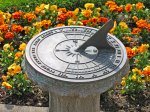 |
Sidney |
British Columbia |
Canada |
Horizontal Dial |
Dial 749 |
| A 10 inch diameter horizontal bronze dial with hour lines, quarter hour marks and Roman hour numerals. The dial face includes a central compass rose. The dial sits atop a fluted concrete pedestal. The dial is gnomonically correct, designed for latitude. |
| |
| |
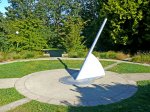 |
Seattle |
Washington |
USA |
Horizontal Dial |
Dial 748 |
| A 35 foot diameter horizontal dial of concrete and stainless steel with an 8 foot gnomon. Hour marks and Arabic hour numerals are shown on the inner circle and outer ring. A meridian line has markers for solstices and equinoxes, for cardinal directions and magnetic bearings. The dial was constructed using material obtained from Boeing Surplus. |
| |
| |
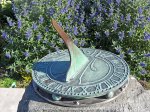 |
Seattle |
Washington |
USA |
Horizontal Dial |
Dial 747 |
| A 20 inch diameter cast bronze horizontal dial atop a 30 inch high one-piece stone pedestal. The dial face has cast quarter-hour marks and Roman hour numerals. The dial, built in 1912, has been refurbished and relocated several times and has a new bronze gnomon. Prof. Woody Sullivan and Kurt Kiefer did the last restoration in 2002. Dial times are inaccurate 5-7 minutes. |
| |
| |
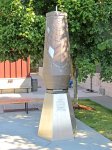 |
Seattle |
Washington |
USA |
Cylindrical Dial |
Dial 746 |
| A unique, 10 foot tall, 2 foot diameter (base) tapered cylinder dial similar to a traditional shepherd's dial except that the cylinder orientation is fixed and the gnomon is rotated about the dial axis by the user to align with the sun. Time is read from the vertical hour and date lines. The dial is fabricated from bronze plate and is hollow. Lines are formed by individually cut hour and date line segments welded on from inside the cylinder. A lever at hand height is moved to rotate the gnomon to face the sun, providing a vertical shadow. A slit in the gnomon tip provides a more accurate sun spot on the dial face. The cylinder is tapered top to bottom for aesthetics and to minimize the effect of solar altitude variation through the seasons. |
| |